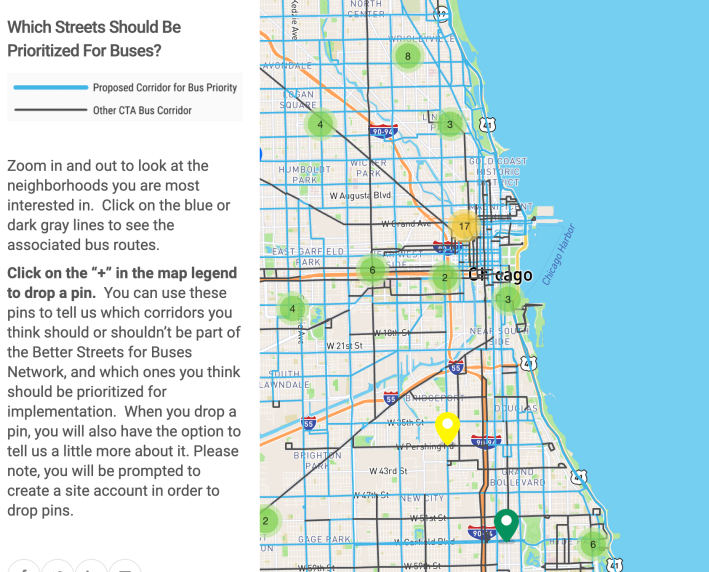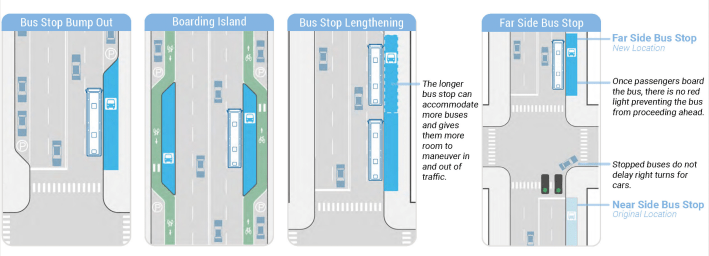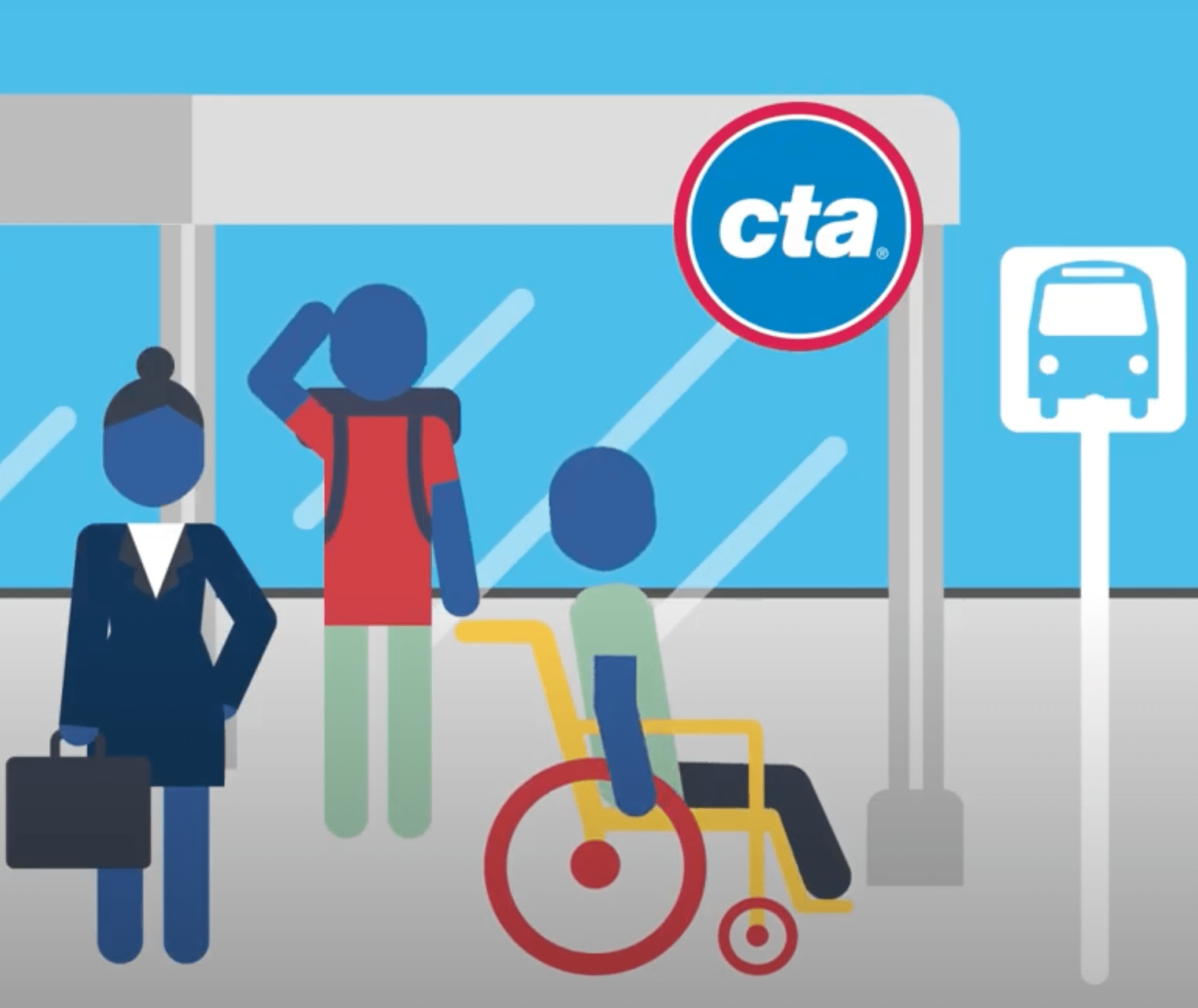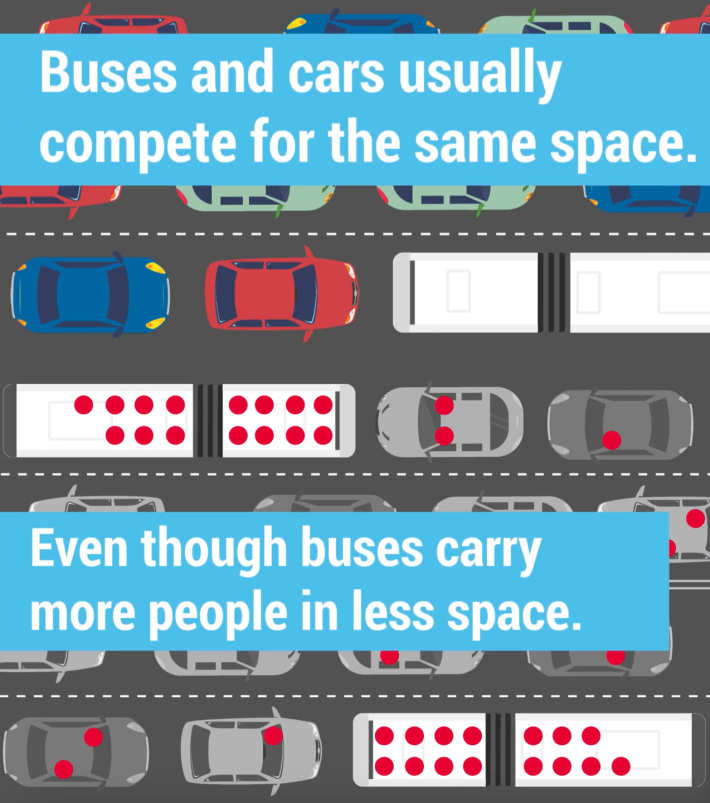Today the CTA and the Chicago Department of Transportation announced that they're seeking public input on the Better Streets for Buses plan, an effort to improve bus service on key routes across the city. The initiative includes a proposed network of streets where improvements will be focused. Residents will choose among options for bus improvements such as enhanced bus stops, traffic signals that give buses priority, and bus-only lanes.
CTA president Dorval Carter said in a statement, “We know that Chicago relies on buses and we are excited to work with our partners at CDOT to help make the public transit bus riding experience better. Buses reach across all of our neighborhoods and for many it is their primary mode of travel. We’re committed to investing in the bus network to improve access to opportunity and ensure all Chicagoans have good options to reach jobs, schools, medical care, parks—and their friends and family. When streets work better for buses, buses work better for people.”
To gather input on the proposed street network and toolbox, the CTA and CDOT have launched an interactive public website at betterstreetsforbuses.com. The project website features opportunities to put “pins” on interactive maps to indicate where residents think a bus corridor should be prioritized, or where bus riders experience issues with buses or use of the street. It also includes an option to take a brief survey, and an “ideas wall” about the types of street treatments that can be used. Input will also be gathered by phone, text, and via paper comment cards distributed at key community locations. The website also provides more information about examples of bus priority projects, a short video about the effort, information on how to register for a virtual public meeting, CTA trivia, a kids activity book, and more. Transit enthusiasts will definitely enjoy browsing the site.
To help lay the foundation for this proposed plan, the two agencies will also be hosting three upcoming virtual public meetings. Those interested in attending one of these meetings can register through the project website. Each meeting session will offer the same information and feedback opportunities. The virtual public meetings will be held on:
- Wednesday, May 4th at 6 p.m.
- Thursday, May 12th at 7 p.m.
- Tuesday, May 17th at 12:30 p.m.
The public comment period is open beginning today through May 31st. Comments and questions can also be submitted via email (betterstreetsforbuses@transitchicago.com) or by phone or text (312-772-5496).

CDOT commissioner Gia Biagi stated, “Developing the Better Streets for Buses plan with our partners at CTA will help achieve key benchmarks within our city’s Strategic Plan for Transportation that sets forth a vision and specific steps towards achieving greater equity through increased mobility. CTA buses are accessible, affordable, and available throughout the city and improving bus service is key to achieving transportation equity in Chicago.”

The development of the plan is bankrolled by a $300,000 Unified Work Plan grant administered by the Chicago Metropolitan Agency for Planning. However, funding for any actual infrastructure improvements is ongoing is yet to be determined.
"We are excited to see CTA and CDOT launch this initiative to make bus service faster and more reliable for the hundreds of thousands of Chicagoans who rely on it," Active Transportation Alliance spokesperson Kyle Whitehead told Streetsblog. "Bus riders deserve a citywide network of dedicated bus lanes to help shrink wait times and get people to their destinations on time."
Whitehead added, "With a wealth of federal, state, and local transportation funds available, and ridership that has still not recovered since the pandemic, now is the time to develop an ambitious community-informed plan and start pouring the red paint this year, next year, and over the long-term. The mayor and City Council should champion this plan and secure funding to implement it as soon as possible."
Metropolitan Planning Council transportation director Audrey Wennink provided the following statement:
Given that the majority of CTA riders use buses, it is critical that we make significant investments to speed up operations. For people to be able to count on buses to get them to their jobs, medical appointments and other time-sensitive obligations, we need to ensure that buses are impacted less by car traffic. This means redesigning our streets and designating a network of corridors where buses have dedicated lanes and transit signal priority. It’s also important to improve the rider experience by providing amenities like real-time information and upgrading bus stops with shelters and better lighting. Given the urgency of our climate challenges and that transportation is the top contributor to GHG emissions, Chicago should be doubling down on improving buses to encourage the use of environmentally sustainable transportation and reduce driving. The current surge in gas prices also highlights how critical it is to have a strong, reliable transit system that provides affordable transportation to all Chicago residents.
Chicago has a long history of sustainable transportation plans that sit on the shelf largely or completely unfulfilled, such as the Ashland Avenue bus rapid transit project and the Chicago Streets for Cycling Plan 2020, plus watered-down bus projects such as the Loop Link corridor and recent pop-up bus-only lanes. In the past, pushback from drivers and merchants, as well as bureaucratic inertia, has stopped the city from implementing robust improvements to speed up bus service, such as prepaid boarding and camera-enforced car-free bus lanes. I hope for the sake of CTA bus riders that the Better Streets for Buses plan is actually realized and produces significant time savings for bus commuters.







